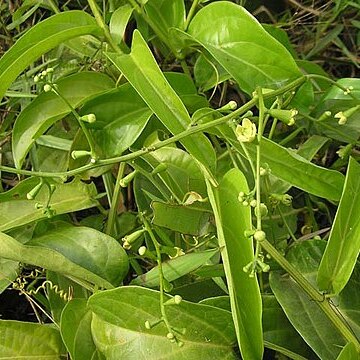Medium-sized liana to 15 m long, woody at base, leafy stem 3(-5) mm diam., dioecious. Probract absent. Tendrils (unbranched or) 2-branched at apex. Leaves: petiole short, older twigs with raised leaf scars; blade simple, unlobed, (narrowly) ovate-elliptic, cystoliths absent, margin entire. Flowers small, creamy-white; buds globose; perianth rotate; sepals 3 (but see note 1), concave, valvate in bud; petals 5, free, ± fleshy, conduplicate-valvate with tips inflexed in bud; receptacle shallow. Male inflorescences paniculate, many-flowered, ± pendulous; bracts small, linear, 1(-2) mm long, glabrous or hairy. Male flowers: pedicel short; receptacle (disc) broad, low; stamens 5, free, inserted on the disc, filaments short, anthers all 1-thecous, opening with apical transverse slit; pistillode absent. Female flowers in (raceme-like) panicles; pedicel short or absent; ovary clavate, imperfectly 3-locular, each locule with apically 2 pendulous ovules; styles 3, short, horizontally two-horned, separate, inserted on slightly raised truncate apex of ovary; staminodes absent or small (see note 2). Fruit rather large, capsular, elongate-cylindrical, claviform, with truncate apex opening by 3 inward curving apical valves. Seeds compressed, longitudinally winged all around the seed, faces smooth, margin faint, edge entire.
More
Climbers, woody. Stem subglabrous. Leaves petiolate, undivided, margin entire. Tendrils simple or bifid. Plants dioecious; male flowers in lax pendulous panicles; female flowers in racemes. Male flower: calyx tube shortly cupular; segments 3, rarely 4, membranous, concave; corolla rotate; segments 5, apex narrow and inflexed in flower bud; stamens 5, free, all of same length, inserted on a fleshy disk; filaments short, thick; anthers oblong, 1-celled; pistillode absent. Female flowers: calyx as in male flowers; staminodes 5, very short, alternate with petals; ovary inferior, at first 3-loculed, ultimately 1-loculed; styles 3, spreading, apex bifid; ovules in each locule 2 or many, pendulous, attached in 2 series to a fleshy parietal placenta. Fruit a capsule, large, narrowly cylindric, clavate, 3-valved at truncate apex. Seeds pendulous, large, oblong, compressed, surrounded by a large membranous wing.

